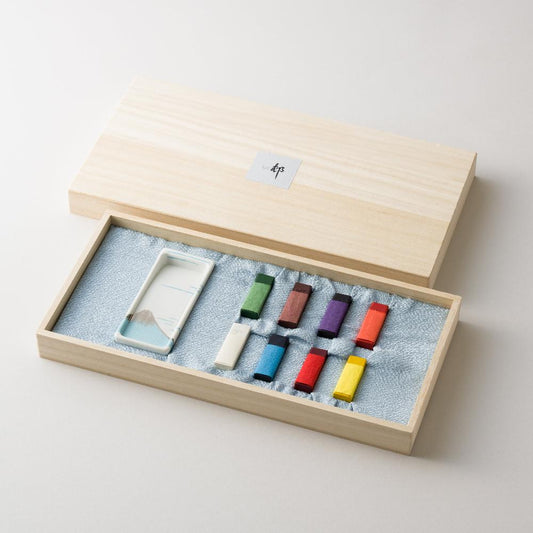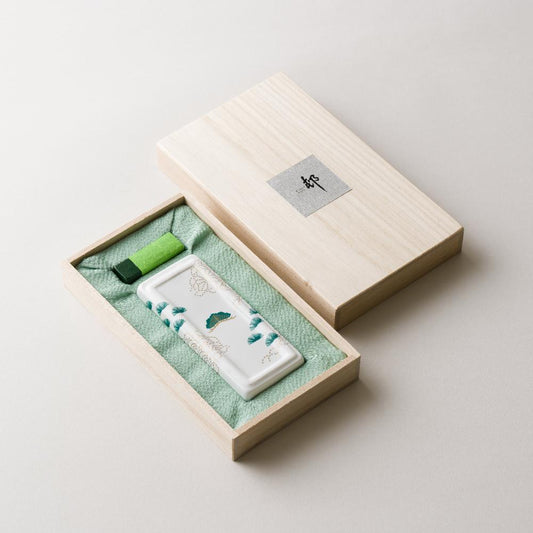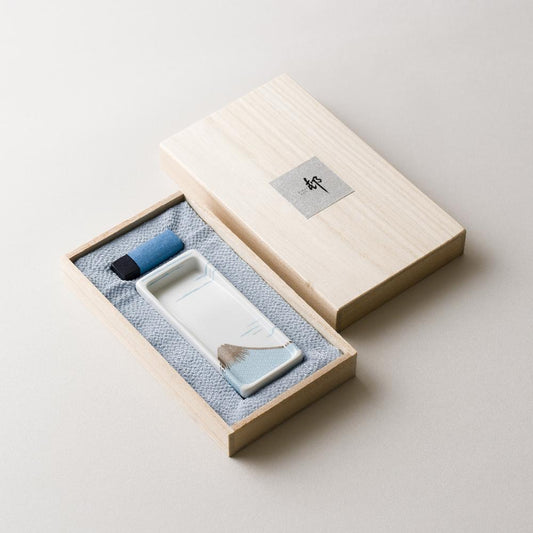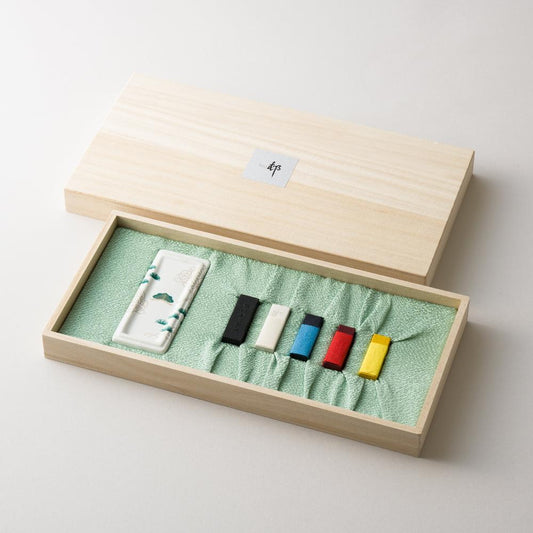Colección: 硯 suzuri inkstone
Dropping water onto the suzuri inkstone, gently gliding the brush over its surface in circular motions without applying force, evokes a peculiar sense of calmness. As you continue grinding the sumi ink, at a certain moment, the subtle fragrance of ink wafts in the air, and you feel a further sense of tranquility settling into your heart. It becomes a special moment derived from the act of grinding sumi ink.
While many aim to shorten the time spent grinding ink to allocate more time for writing or drawing, the reality is that the time spent grinding sumi ink on a suzuri inkstone is not necessarily lengthy. A good suzuri inkstone, in fact, provides a sense of enjoyment in the grinding process.
In Japanese calligraphy, which is not merely a form of calligraphy or artistry but rather 'Shodo' - the way of writing, each step in the process is a comprehensive art form that hones sensitivity. It's important to cherish the moment and value the insights gained through the process of grinding ink on the inkstone.
At 'rimpamura,' we offer a variety of carefully selected special suzuri inkstones made in Japan.
-
【赤間硯: 日枝玉峯堂製造】 AKAMA suzuri (oval)
Precio habitual $235.00Precio habitualPrecio unitario / por -
【赤間硯: 日枝玉峯堂製造】 AKAMA suzuri (Lingering moon)
Precio habitual $248.00Precio habitualPrecio unitario / por -
【KISHU & ARITA】 Arita Porcelain suzuri (OMOTE) - FUJISAN & 8 watercolor sumi ink sticks good for calligraphy and sumie painting
Precio habitual $222.00Precio habitualPrecio unitario / por -
【KISHU & ARITA】Arita Porcelain suzuri (URA) & SAIEMBOKU, watercolor sumi ink stick
Precio habitual $79.00Precio habitualPrecio unitario / por -
【KISHU】Arita Porcelain suzuri (OMOTE) & SAIEMBOKU, watercolor sumi ink stick
Precio habitual $79.00Precio habitualPrecio unitario / por -
【Ogatsu Suzuri】 by Masaru Yamazaki
Precio habitual $645.00Precio habitualPrecio unitario / por -
【Tosa Suzuri】 Nakamura Suzuri by Issui Kobo
Precio habitual $300.00Precio habitualPrecio unitario / por -
【KISHU & ARITA】Arita Porcelain suzuri (URA) comes with 1 KISHU SUMI & 4 SAIEMBOKU
Precio habitual $196.00Precio habitualPrecio unitario / por
-

硯 akama suzuri inkstone
To know moreThe Akama suzuri is an inkstone produced in Shimonoseki and Ube.are in Yamaguchi Prefecture, Japan. An Akama suzuri dedicated to Tsurugaoka Hachimangu Shrine in Kamakura by Minamoto no Yoritomo tells that its history dates back to the Kamakura period. It is known that production of Akama suzuri began in the Kamakura period, boasting a history of over 800 years.
-

硯 Arita Porcelain suzuri
To know moreThe white inkstone makes it easy to see the shade of the ink, so you can enjoy the beauty of the gorgeous colored ink as well as the time you spend grinding the ink with a rich mind. Arita Porcelain suzuri is easy to care for. Just a little of water easily removes ink stains therefore you can keep the whiteness of the suzuri.
what's new
Ver todo-

Maki Fude (cored brushes) vs Suihitsu (non-core...
A Makifude has Japanese paper wrapped around its core; therefore, only about one-third of the bristles on a Makifude brush are exposed for use, while the bristles of a Suihitsu...
Maki Fude (cored brushes) vs Suihitsu (non-core...
A Makifude has Japanese paper wrapped around its core; therefore, only about one-third of the bristles on a Makifude brush are exposed for use, while the bristles of a Suihitsu...
-
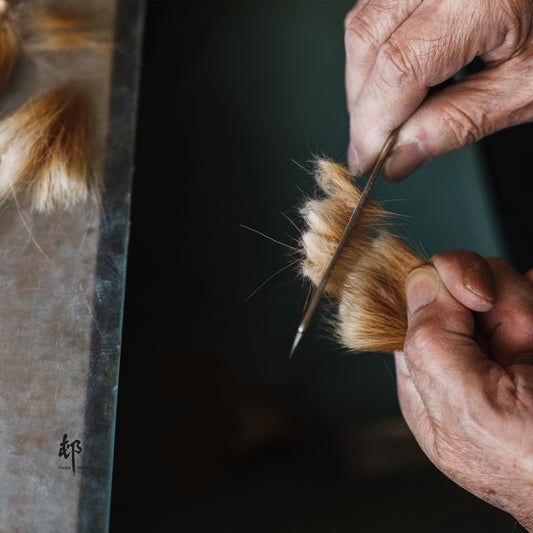
Two different ways of making brushes
Fude making has been practiced throughout Japan for centuries, and while the manufacturing methods can vary somewhat depending on the region and shokunin, they can be broadly categorized into two...
Two different ways of making brushes
Fude making has been practiced throughout Japan for centuries, and while the manufacturing methods can vary somewhat depending on the region and shokunin, they can be broadly categorized into two...
-

Season of Sumi making is over this year. Sumi i...
The production of sumi ink takes place during winter. This is because one of the raw materials for sumi, Nikawa glue, may not solidify or may even rot when it...
Season of Sumi making is over this year. Sumi i...
The production of sumi ink takes place during winter. This is because one of the raw materials for sumi, Nikawa glue, may not solidify or may even rot when it...
-

Yoichi Hieda awarded at the 47th Yamaguchi Trad...
It is our great pleasure to announce that Yoichi Hieda is awarded the "Japan Crafts Association Yamaguchi Branch Director's Award", the equivalent of the first prize, at the 47th Yamaguchi...
Yoichi Hieda awarded at the 47th Yamaguchi Trad...
It is our great pleasure to announce that Yoichi Hieda is awarded the "Japan Crafts Association Yamaguchi Branch Director's Award", the equivalent of the first prize, at the 47th Yamaguchi...



